The Rise of Radioactivity
This week, we are looking at radioactivity, from its uses in medicine to its uses in war. Plus, a sneak preview of a new film due out soon all about radioactivity pioneer Marie Curie. Plus, a new 90 minute test for coronavirus infection, how fast is the new coronavirus mutating, and evidence that humans are just like dogs - we eat much faster if there’s someone else around!
In this episode
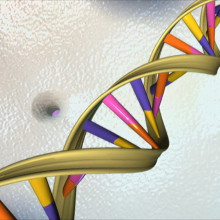
Two-hour coronavirus test
Dami Collier, University of Cambridge
“Test! Test! Test!” the World Health Organisation have said, counselling the world on how it should proceed in trying to gain control of the coronavirus pandemic. But scaling up to offer tests to large numbers of people, as well as making tests fast and agile, has proved difficult. Now researchers at the University of Cambridge and the company Diagnostics for the Real World, have repurposed a rapid HIV test so it can detect coronavirus infections in just ninety minutes. The system generates multiple copies of the genetic information for the virus - if it’s present - and then produces a visible pattern of three lines on a read out... as well as an electronic log of the results. Chris Smith spoke with Dami Collier who’s been working on the new system...
Dami - This is a rapid diagnostic test for COVID-19, so it's rapid in the sense that from taking the sample from the patients, which is usually a swab of the back of the throat and the nose, to the point of being able to give them test results has been cut down dramatically, from what is ordinarily between one or three days, to two hours. So it is a game changer for people who are meeting patients on the frontline. In A&E departments, in general medical departments, you have to make rapid decisions about where these patients need to go, so that one, that they're cared for appropriately, and two, if they are infectious, other patients are protected from getting infected.
Chris - How does this test work and how have you been able to do in a couple of hours what was previously taking or is still taking laboratories days to do?
Dami - This machine is based on a technique called PCR, or polymerase chain reaction, which can take a copy of genetic information, and copy it many times over so that it can be detected. In clinical practice, we'll take a swab of the throat, or the nose to try and pick up some virus, and then put it in the machine and the machine can then copy this many times over and allowing us to detect it on the test strip. And it can do this in the space of two hours.
Chris - Was it invented for this purpose or is this a case of a re-purposing? You took something that already existed and was being used for something else and realised, Oh, you could do this with it.
Dami - Oh yeah. So it's really the very clever people at Diagnostics for the Real World who then repurposed the machine that was initially developed to test HIV and turned it for use to try and address this problem we're having with the coronavirus pandemic.
Chris - So talk me through then if I came in and sat in the waiting room at a hospital, and one of these machines was running there, what would happen to me in order to give me my diagnosis in two hours? What would you do to me?
Dami - Okay, so we take a swab from the back of your throat with a little cotton ball and we'll take the swab, which hopefully has picked up some virus, if you're carrying some, into a tube of fluid that makes it safe to handle. We then pop this into this machine. It's connected by Bluetooth to a tablet, which tells us when it's ready to read the test, and it reads out the test for us. But also we can have a look at the test strips ourselves and see if are there lines in there to suggest that the test is positive.
Chris - While the machine is testing me though, can you use it to test you, or while it's testing me, is it completely stuck testing me for the two hours it takes to give me my result?
Dami - Yes. So this machine tests only one sample at a time.
Chris - So there is potentially a bottleneck there then isn't there? In the same way that we're currently at a bottleneck with testing people at scale across the UK and other countries, we've still got potentially a bottleneck here. Your results are coming out very quickly, but you're limited by how many machines you've got.
Dami - Yes, exactly that is true. There will be a bottleneck there. However, these machines I think can serve certain populations very well. So if you can imagine in an A&E situation where you have to make a decision, does this patient need to go into a side room for the care they need right now, then it can help to help you facilitate those sorts of questions very quickly.
Chris - And in terms of actually how it works, is it better or at least as good as the tests that we currently have, that are being done in say, Public Health England laboratories across the country?
Dami - The right thing to do with new technology or tests is to evaluate it thoroughly. And this has undergone clinical evaluation at Addenbrooke's Hospital, where we were able to test over a hundred patients, half of whom had confirmed positive COVID-19 and the other proportion who didn't, and it's coming up with a sensitivity of almost 99%, which means that if there were a hundred people in a room who had, COVID-19 it was able to detect 99 of them, which is very good for a diagnostic test. And also it wasn't picking up any tests and calling them positive when in fact they were negative. So in fact it has 100% specificity. So I think there'll be lots of interests from lots of places up and down the country.
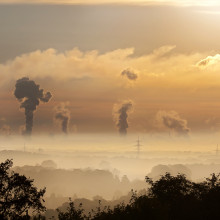
06:18 - Pollution drops under lockdown
Pollution drops under lockdown
Victoria Gill, BBC
This period of coronavirus lockdown is dramatically changing our outside environment - closed shops, quieter roads, emptier parks. One town in Wales has even been invaded by goats lured in from the surrounding hills by the absence of people! And with fewer cars and buses on the road, and fewer planes overhead, what impact is lockdown having on our air quality? Katie Haylor spoke to BBC science correspondent Victoria Gill, who explained that pollution levels in the UK have dropped sharply, particularly noticeably in cities...
Victoria - We've actually very recently had a measure from some ground based measurements showing reductions in some pollutants that we know are bad for our health, and we know are associated with the kinds of activities that have dropped so sharply since we all were sort of plunged into this coronavirus induced lockdown. So things like transport and industry, so nitrogen dioxide and particulate matter. So that's small particles, and we know that they can do some damage in our lungs. Particularly particles under a certain size can sort of get right down into our lungs. Scientists and public health specialists are really interested to see what will happen as this lockdown continues, because there's not much good news coming out of the coronavirus crisis, but it does seem to be inadvertently improving our air quality.
Katie - How are scientists actually measuring this drop?
Victoria - We've seen a number of different measurements actually, and this is an international effect. We've had some measurements that have come from China and from India. We're also, I should say, seeing a drop off in carbon dioxide, some of those greenhouse gases as well. In Europe we saw a really interesting measurement come from some satellite based spectrometry, measuring the colours that are being reflected from the sunlight that's hitting the Earth, and those different colours represent the reflections from different types of gas. You can see different types of pollutants and take that colour intensity as a measure of the amounts of those gases. We then saw from the National Centre for Atmospheric Science, these city-based ground measurements that really give us a measurement of the air that we're breathing, and we're seeing the same thing across the UK.
Katie - Is it possible to determine what impact this could have?
Victoria - A lot of what will happen in the longer term will depend on how quickly some of those pollution driving sectors bounce back. So for one thing, we've heard from the UK government that they're going to be phasing out the sale of vehicles that have internal combustion engines, and moving to electric vehicles. What we can maybe see over the next however many weeks and months that we are kind of stuck in this lockdown, is a realistic measure of the kind of target that we'd be looking for when we take a lot of those diesel vehicles off the road and replace them with electric vehicles. So there could be some longterm better, more informed targets for air pollution. The worry is that once this immediate crisis is over, there'll be a drive to just restart the economy without any of that in mind. So I think public health specialists and atmospheric chemists will be trying to kind of, build in some good practical advice into how we may be keeping some of these benefits to the air that we're breathing.
Katie - Do you think there are any lessons we can learn in terms of pollution, if we look, you know, to people who are a bit ahead of us?
Victoria - There's something positive that we can take from this unintended consequence of what's happening in so many places. You know, we've seen a quarter of the world under lockdown, and lockdown means less transport, less industry. It means less pollution. Now, if we can monitor the effect that that is having on people's cardiovascular health, on people's ability to kind of, breathe clean air, but also take some lessons from it in terms of what our streets and urban centres could look like, if we can limit that pollution and limit that transport. I think we're all learning lessons about how the world could change. You know, there's been a huge amount of frustration, especially from kind of, the younger generations and activists in the environmental movement, about how slow we've been to respond to the emergency that is climate change. And what this does show us, is that when there's an emergency that is immediate to our public health, we can act and we can put in some really severe measures. And I'm not suggesting that governments are going to do anything along this scale to tackle climate change, but it shows what's possible. Maybe we can take some lessons from this in order to apply it to that bigger global emergency that is, you know, the state of our planet and our warming world.
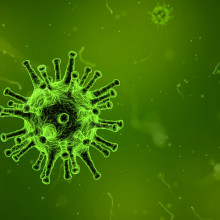
11:30 - Tracking coronavirus mutations
Tracking coronavirus mutations
Richard Neher, University of Basel
As the coronavirus spreads around the world, it’s steadily mutating its genetic code, introducing fingerprint changes that scientists can track. These can highlight how the virus has moved between countries and how fast it’s evolving. Phil Sansom caught up with Richard Neher, from the University of Basel in Switzerland. He’s one of the people behind Nextstrain, an open source project that’s been responsible for creating and analysing coronavirus ‘family trees’...
Richard - It really has been a bit of a whirlwind development. So recall that this outbreak was first announced in the very end of December last year. By January 9th, we already had the first complete genome sequence of this virus available. And then over the weeks that came, we got more and more of these genome sequences that came in. By comparing these genome sequences to each other, we immediately got very good sense of that this is a single outbreak. These genomes were essentially identical. There was maybe like, one or two differences here and there, and for an RNA virus was a fairly high mutation rate. That implies that these genomes had a very recent common ancestor only a few weeks in the past.
Phil - And when you say the genomes were coming in, are people sending them to you orwhat are they doing?
Richard - No, and that's an important point. GISAID, which is a database that's used for influenza data sharing.
Phil - GISAID?
Richard - GISAID. The Global Initiative for Sharing All Influential Data. They have jumped in and provided their infrastructure and terms and conditions. Their sort of sharing mechanisms for the coronavirus sequencing community. So that has enabled labs all over the world to share their data for analysis.
Phil - How many genomes and sets of data are they getting?
Richard - We now have more than 2000 full genomes available, and we can't look at all of them at the same time anymore. There's simply so many. It's been the first time that this sort of, real time sequencing, sharing and analysis is playing out.
Phil - Now you said those first few were basically identical. What's happened as the virus has gone all around the world?
Richard - As RNA viruses do, they mutate, not every other day, but about twice a month. That is sort of our current estimate.
Phil - And these aren't mistakes that are going to kill the virus.
Richard - Well some of them will kill the virus, but those are just dead ends, right? So the only ones that we see are those that don't kill the virus. They don't necessarily make the virus more aggressive or anything like that. Most of these mutations likely just don't really have too much of a significance. But what they do allow us to do is group viruses together. You know, a particular virus that got sampled in the US is similar to a virus that got sampled in Europe somewhere. That sort of, gives us an idea how the virus is dispersing and how different outbreaks in different places might be connected.
Phil - So how has this been useful as the virus has gone to continent after continent?
Richard - Early on when there's an outbreak in some country, politicians are very happy to say, well, we closed the borders and problem is solved, right? That has never worked. Surprise. And the sequences, they can tell you that this decision is wrong, right? If you see many sequences that are very similar in your country, they probably were transmitted locally. So this is not a problem that you solved by closing borders, but this is a problem that you have to solve by clamping down on transmission in your community.
Phil - Have you found weird cases where viruses have spread in ways that you haven't expected? And you can tell that from seeing the full genomes of the virus.
Richard - So we've certainly seen, especially in the last week or two within Europe, this viral population is very well mixed. There is not a single place this virus is coming from anymore. And this has to some extent been surprising, how rapid and thorough the spread has been. Anyone can go online and see this, you'll see both a family tree of the virus and a map that shows you where on the planet these samples come from. And one has to be very mindful of the gaps that are in those data, because mutations happen randomly. Sometimes there is no mutation for like four weeks. Sometimes there's three mutations in a week, and this means that seeing two things close together in the tree doesn't necessarily mean they were in the same place in time.
Phil - Now obviously we're in this pandemic for sort of, the long haul. What's the point of all this virus family tree mapping?
Richard - Well most obvious data that we have about this outbreak is the number of cases in different places, but what do these sequences give us? They add structure to these numbers. It's not just sort of, 10,000 cases in New York or something like that. Suddenly you can break this down into multiple variants. So you know you have not one outbreak but you might have three outbreaks that sort of, originate in different places.
Phil - And how is that practically useful?
Richard - It helps you focus infection control measures that you put in place, as you just said we're in this pandemic for a couple of more months for sure. Right. So we'll have to understand, where this virus is transmitted, having the ability to use genome sequences to identify these transmission chains, and transmission clusters gives you means to target infection control measures.
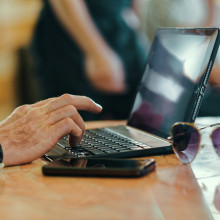
17:22 - How secure is Zoom?
How secure is Zoom?
Peter Cowley, Angel Investor
In recent weeks we’ve all become home remote workers. And that means we’re relying on video conferencing software like Skype and Zoom. And this has led to concerns about the security of the information being exchanged. Adam Murphy was joined by tech commentator and angel investor Peter Cowley…
Peter - Zoom is one of these many platforms for video conferencing. So as consumers we tend to use FaceTime or Skype or WhatsApp or House Party, the new one that people are talking about. And for businesses tend to use Microsoft Teams and Go To Meetings and and Cisco WebEx. But it also Zoom. Zoom we also use actually privately, I'm going on to a drinks party after this on Zoom with people in various places around Europe. So basically it's people getting together in a single place using audio and video.
Adam - And with all these people together in one place, is it secure?
Peter - As has been reported in the press quite a bit recently, Zoom, which has grown quite rapidly and become very much the dominant player in recent years, is not concentrated quite as much perhaps on privacy as they should. And this is what they've self-declared, it isn't something that I've made up. There's been things like, something called Zoom bombing, which is where somebody suddenly appears on it and says something rude or derogatory or has an image there which they definitely shouldn't be showing. Information has been passed to Facebook. People can join a meeting just knowing the ID and famously the cabinet's Zoom meeting was published on Twitter with the ID on it as well, so that effectively if somebody typed that in, they could have possibly joined that. Email addresses have been lost, etc. The big issue with Zoom is it's what's in the industry is called a very large attack surface. There are probably at any one time, hundreds of thousands of millions of Zoom calls going on. So that means it's quite easy for people to get in. I mean people who are doing naughty things, not you or I of course, get into some of these calls.
Adam - And you mentioned it was passing data to Facebook. What kind of data is passing on?
Peter - I don't know and they seem to have cleared that. So there are a number of things have happened. They've now stopped any new features. I've actually got a Zoom Pro account myself and the number of features there, the settings is phenomenal. So there's more features than probably any of us will use. So what they're doing is basically closing these loopholes, or closing the loopholes that have been found so far. Like any internet giant or any software, really the things that could be leaked are data, of course, I couldn't tell you what Zoom has leaked, if anything has leaked. And also selling, I mean we've been through this before with Cambridge Analytica, haven't we? Here in Cambridge a couple of years ago.
Adam - With all this happening, what can people do to keep themselves safe on Zoom?
Peter - Two or three things which are being introduced and I see that even on this meeting, it's coming up in about an hour's time, passwords. So having a password there. Most meetings you get in, you get a link. If that link leaks, anybody can get into it. But if you've got a lot of participants, and I was on recently one with a hundred, there's no way you can see everybody. Something called waiting rooms or lobbies? So you can't get on immediately. You've got to get into this waiting room and then you're let in by the host. Again, this means they can't come in, they can't Zoom bomb. You should mute your own video and your audio of course where you're not needed. If you're the host, you mustn't allow guest screen-sharing, that way the Zoom bombing can't occur. So there's quite a lot of just good practice that people haven't been doing.
Adam - And then what about our mobile networks and our smart phones and all this? How secure are they in the current situation?
Peter - Well a couple of things there. One is that some countries are actually using the mobile phone networks to do couple of things. One is to contact trace so they can see if somebody's had COVID, who they've been near. And secondly social distancing, because the data is accurate enough they can actually see. So this is very Big Brother-ish and I hope it doesn't get to many other countries like the UK. The other thing you might've seen is that people are somehow blaming 5G for COVID transmission and they've been setting fire to 5G mobile masTs and there's been seven or eight of them here in the UK being set fire too. I really can't see the connection there between how a 5G signal, which is yet another mobile signal, but no different really from the ones we've have been used to for the last 20 or 30 years, and COVID. But they seem to think they are.
Adam - And so you won't be stopping using 5G?
Peter - I certainly won't be stopping using 5G and I won't be stopping using Zoom, but I am very pleased to see that these other facilities like the passwords and the lobbies, things I didn't know about a week ago, which I do now.

21:45 - Perception changes how you eat
Perception changes how you eat
Claudia Wascher, Anglia Ruskin University
Now here’s some food for thought! Scientists have found that when you’re snacking, you reach for the food more often if you’re with someone else than you would than if you were by yourself. In this study from the University of Tokyo in Royal Society Open Science, people were given plates of crisps, and grabbed more handfuls when another person was there - even though they didn’t necessarily eat more overall. The authors suggest that it might be because you don’t want someone stealing your food - but is that really what’s going on? Phil Sansom got the independent perspective from Anglia Ruskin University behavioural ecologist, Claudia Wascher...
Claudia - They have basically asked humans to eat crisps for them and they have told the participants that it's about a taste experiment, so the participants had to fill in, "Yeah, crisps were crispy and salty and actually tasted good." But indeed the researchers had a completely different study aim. They actually wanted to find out the eating behaviour of the participants if they're tested alone or with other individuals.
Phil - What's actually physically going on when they do this experiment? Do they sit someone down in a room and they give them a little bowl of crisps and then there's someone across the table from them?
Claudia - Yes, they have tested approximately 60 participants and one group was the ones who were tested alone. Another group was tested with a partner, so when they came into the room there was somebody else sitting opposite them. And then they had a third group. They basically had an opaque barrier so they couldn't see the other individual eating crisps, but they could only hear them.
Phil - What kind of crystals were they?
Claudia - I don't think that they say in the paper because obviously they don't want to do product placement. And this actually could be a conflict of interest for the authors if -
Phil - Was this a study sponsored by Pringles? [laughs]
Claudia - Exactly!
Phil - I have to say, it sounds like a fun study to be involved in.
Claudia - Yeah, it's fun. I think the background of all of this is no matter whether it's humans or birds or fish, foraging in groups has benefits for the individual, so it's less likely that they're eaten by a predator. It's more likely that they actually find foods because they have more eyes to look out for food sources, but once the group has found some food sources, of course there's more competition.
Phil - What did they actually find then?
Claudia - So they found that when there were other people in the experiment that participants grabbed pieces of crisps more often, they didn't necessarily eat more crisps. They authors conclude that people must have taken smaller pieces of the crisps.
Phil - Why then would people have taken crisps more often but maybe a little bit less?
Claudia - They are arguing that it's a competitive situation. You find some food and you basically have to hurry up and get as much out of the food source as possible.
Phil - You're worried someone's going to eat your crisps.
Claudia - Exactly. And the authors kind of said that taking smaller pieces more often could be tactical consideration. I think we all can relate to this. Another explanation which I think is worth mentioning is social facilitation. You're more likely to engage in an action if other individuals are engaged in that action too. Think about other animal species. For example, if you forage in the wild and you're given a bag of crisps in front of you, initially you wouldn't know like are they actually safe to eat? So it might be worth to actually watch other individuals eating them and kind of make a decision, "it's safe to eat this."
Phil - So you're saying it might be like a social activity, like you see someone else eating crisps and you say "oh OK, I'll eat more".
Claudia - Exactly. This is also something, they put two strangers into a room with a plate of crisps. This is a bit socially awkward! We are all group living animals. However, when we meet strangers in the first instance, you will want to know are they a friendly person, and engaging in an activity like eating or even mirroring the activity of the other individual, might kind of signal getting to know each other, getting familiar with each other. Yeah. I think it's a quite fun story to do to kind of test what makes humans tick when they eat. And again, it might be a very unconscious thing which we are not quite aware that it's actually happening. And I think it's fun to get to know people a bit more by doing this kind of experience.
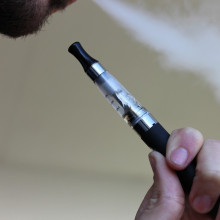
27:03 - Can you get coronavirus from a vape cloud?
Can you get coronavirus from a vape cloud?
In our mailbox this week, Chris Smith answers the question of whether you can get coronavirus by inhaling vape clouds...
Chris - This is something I’ve wondered myself, actually. In fact, I followed a car along a road in the past, and been able to smell what the person in the car in front of me was vaping. And this got me wondering, well, if I can smell that, that’s presumably air that was previously in the lungs of the occupant of that car. And, if I can smell the vape molecules, could there also be infectious particles of virus, for instance, their rhinoviruses or adenoviruses, or in the current situation, their coronaviruses, which are making their way into my car too.
Well, I think the likelihood of that happening is extremely remote, because the amount of dilution of the air between them and you is going to be extremely considerable. But, the fact that you can smell the vape, shows you that molecules, that have that smell, were in that person, and they are telling you where the air from that person has gone.
Now that means, in theory, if there were some virus particles amongst those vape molecules, they could be following the same path, and they could also, therefore, end up in your face. There are some considerations though, which make this extremely unlikely as a route of transmission.
The main one to consider is that the vape molecules, that give it the smell, are really tiny, but the particles of virus are considerably bigger, and they’re also in droplets of water, largely, from the person’s respiratory tract. So although they’ll move a considerable distance, and they’ll bob around in the air, they won’t travel as far, and they won’t travel as fast as the smoke, or vape, from someone vaping.
So what you can regard this as is almost as a proxy for where the air from another person is going, and it should serve as a warning for how fast air can move smells and smokes, and possibly viruses around. But also take comfort from the fact that, probably the amount of virus, by the time it’s gone from that car, out of the window, and through the air conditioning unit of your car, and into your face is going to be, really, very tiny. And almost certainly lower than an infectious dose.
But if you were sharing a room with that person, or even their car, you’d be at a much greater risk, because the close proximity to them means that the virus particles would be in higher concentration, and you’re more likely to inhale what we would call an infectious dose, which in the case of this virus is probably around 20 virus particles.

30:11 - The life of Marie Curie
The life of Marie Curie
Marjane Satrapi, Sam Riley
Adam Murphy was lucky enough recently to play film critic, getting a sneak peak at “RADIOACTIVE, a new film that tells both the scientific and romantic story of Marie Sklodowska-Curie and her husband Pierre Curie - the couple whose pioneering work led to the discovery of the radioactive element radium - and the reverberations of their discoveries across the 20th Century. Adam got to speak to the director Marjane Satrapi, and the actor who plays Pierre, Sam Riley
Rosamund Pike playing Marie Sklodowska-Curie - Science is changing and the very people who are running science are the people who believe the world was flat, I'm going to prove them wrong.
Adam - Marie Sklodowska-Curie and her husband Pierre Curie are true pioneers in science. Marie remains the only person to have Nobel prizes in different sciences, physics and chemistry for her work on radioactivity and for her discovery of polonium and radium. And she is the subject of an upcoming biography called Radioactive starring Rosamund Pike. And I was lucky enough to get to sit down with director Marjane Satrapi and actor, Sam Riley who plays Pierre to chat about a movie so grounded in science.
Marjane - The problem, you know, with showing a scientific work in cinema it’s not that the science is not exciting, the science itself is very exciting. But that is like the procedure of creation. Like when I create, you know, if you feel me creating, basically my mouth is half open and I'm, you know, looking into some kind of empty space. So it's nothing really attractive to see, to tell you the truth. And science is a repetitive work most of the time. So you know, to show that I'm making it exciting, it's not this easy. And then you cannot make a movie about two scientists and never talk about science because this is a fraud. So you have to talk about the science. So then you try to be as accurate as possible, you know, show, you know, an atom of a radioactive element as an atom of a radioactive element would look like. Because unlike art where it's, so my personal interpretation, it's something extremely objective and factual about science that makes it so exciting, because there is no place for your personal interpretation.
Adam - So what do you do when you're an actor and you have to step into the role of someone who's real?
Sam - I've played real people before, but I've always been lucky that they weren't contemporary people. You know, because if I was to play Boris Johnson, people know his mannerisms and his gestures and people would be observing whether I'm doing a good impression of somebody. Yeah. And I think at the end of the day, one is trying to find an emotional truth with something. I remember my son telling me that when I'm explaining the science, it would be good if I look like I know what I'm talking about. But the rest of it is human emotion and human feeling. And when you're working with great people like Rosamund, you know, you look at them in a moment and you believe what they're saying and then you're reacting to that. It's a like a reaction in itself, I suppose. And exactly as Marjane expressed, that's what people, when they're watching it understand and can relate to because it feels honest.
Adam - Now having spent all that time deep in the story, what does Marjane think the legacy of radioactivity is?
Marjane - So there's this whole boom going around radium because suddenly as it can cure cancer, it can cure anything. So you have all these different product from, you know, the face powder to the radioactive cigarette, it's incredible what happened. But then 39 years after the death of Pierre Curie and 11 years after the death of Marie Curie, you have the atom bomb, 1945. And this is what has happened. So, you know, can we make a direct link between the scientists that they were and the atom bomb? Obviously not. Because you know, they discover something. They even didn't invent something like Nobel did, you know? Radioactivity exists in the nature. They discovered something that already existed. Is that for this that you know, we can completely reject the idea of the radioactivity? I don't think so because you know, this is always the question of ignorance towards the knowledge. When you're ignorant, you're so sure about all your beliefs because the less you know, the more you're certain that what you know is right. The more you know, the more you understand it’s complex. And then you start having doubts about everything.
Adam - And what about the Curies? What's their place in history?
Marjane - For me, it's like, wow, they're still today, they're the couple of the future.
Sam - That's absolutely true. Yeah.
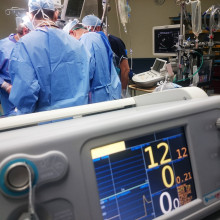
Radioactivity and medicine
Tom Roques, Norfolk and Norwich University Hospital
A lifetime of exposure to high levels of radioactivity eventually killed Marie Curie. Her notebooks are still too radioactive to handle safely. But radioactivity is used routinely and very effectively in medicine to cure disease. So how does that work? Chris Smith was joined by cancer specialist Tom Roques, from the Norfolk and Norwich University Hospital...
Tom - So I guess you could think of radioactivity as lots of tiny bullets of energy which can go through the body's tissues. And they can damage the DNA, the life code inside cells. If they damage them a lot, that cell can die, and we use that in medicine with radiotherapy. But if the damage is more minor then you can get mutations in the DNA and those mutations over time can add up and cause cancer.
Chris - And are any particular parts of the body vulnerable? Or is there any part of the body susceptible to this happening?
Tom - So the parts of the body that are more susceptible to damage from radiation are the parts where the cells are growing quickly. So again, with the radiotherapy that we use, the tissues that tend to have more side effects from radiation are things like your mouth and your gut, where the cells are growing and dividing all the time; rather than parts like your brain, which tend to be fairly stable.
Chris - And so it's the fact that cells which are dividing are susceptible to being damaged by the radiation: that's why you can actually turn this around and say, rather than worrying about it causing cancer, if someone's already got cancer, you can use the vulnerability of fast growing cells to hit them with a dose of radiation and kill them?
Tom - We use the fact that cancer cells tend to be growing more quickly than normal cells. So in normal cells, the DNA is packaged away very safely and tightly inside the nucleus of the cell, so it can't be hit by these bullets of energy that the radiotherapy gives. Whereas cancer cells, their DNA is outside being divided and grown, and that makes them more sensitive to the radiation.
Chris - When you use radiation therapeutically in this way, what sort of radioactivity do you use? What's the source?
Tom - So I guess that's the other difference between now and the radiation that the Curies were using. They were using naturally occurring radiation, which you can't turn on and off. Now in hospitals we use a machine called a linear accelerator, which is about two million pounds worth of high-technology kit with a generator of particles that hits a tungsten target, and its that that produces the energy of radiotherapy; but you can turn it on and off. So when the machine is off, it's perfectly safe to go into the room, and when it's on, only the person in the line of the beam is actually affected by the radiation.
Chris - So you zap a person's cancer, if you know where it is, with a dose of radiotherapy to destroy the cells, hopefully. But why doesn't that radiation then damage more healthy tissue and cause the person to have more new cancers?
Tom - So it does damage that healthy tissue, but to a lesser extent. And over the years, doctors have learned ways of minimising the damage to the normal parts of the body, while maximising the damage to the cancer. So for example, most of the time when we're trying to cure cancer, we give radiotherapy in lots of little repeated doses over a number of weeks, with the hope that the normal cells are better at repairing damage to their DNA and so can recover overnight, if you like, whereas the cancer cells tend to die more easily.
Chris - Is the same true therefore when we use a degree of radiation exposure to do imaging? I'm thinking things like X-rays and CT scans, we're using a dose that's useful to us in terms of imaging the person but not sufficiently large that we're going to cause a big increase in risk of them actually getting a cancer.
Tom - Yeah, so the energy that we use for imaging is much less than for radiotherapy because you're not trying to kill any of the cells or to damage them at all. So the energies that we use are much less, but every dose of radiation we gave - whether that's an X-ray or a CT scan - does give some radiation, which in theory could cause damage at a very low level in cells. So doctors always try to minimise the dose of radiation that we need and not put people through scans that they don't need.
Chris - And how else can we actually use radiation in order to image? Because obviously people will be familiar with things like a chest X-ray, or going in a CT scanner, the thing that looks a bit like a doughnut; but what other measures and mechanisms have doctors like you got at your disposal?
Tom - So I guess the most exciting change in the last 10 years or so has been things like PET scans. So a CT scan will give you a 3D picture of the inside of your body in different shades of grey, but it doesn't tell you what the tissues inside the body are doing. We use the fat that cells that are growing and dividing need sugars like glucose in order to grow, and if you give someone some glucose and make it radioactive, you can detect where that glucose is going, and show up in different colours where areas of cancer are. So that enables us to find cancer where we couldn't otherwise see it.
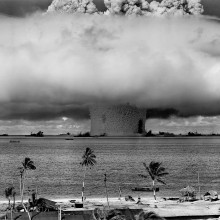
40:58 - Making a nuclear bomb
Making a nuclear bomb
Now, it would be remiss of us to discuss radioactivity, and not discuss the darker side of this science, as Adam Murphy has been finding out from Alex Willerstein from the Stevens Institute of Technology in New Jersey...
Adam - One of the most infamous uses of radioactivity is to turn it into a bomb, an atom bomb. These bombs have only been deployed against humans twice, at the end of World War II, on Hiroshima and Nagasaki in Japan. Countless lives were lost both in the initial blast and due to the radiation afterwards. But how does an atom bomb work, and how were they developed? I spoke with nuclear historian Alex Willerstein from the Stevens Institute of Technology in New Jersey about the development of the A-bomb.
Alex - The United States didn't really start trying to build an atomic bomb until early fall of 1942. That's when it decided that the splitting of atoms is not just an interesting scientific phenomena, but could be in a relatively short amount of time made into a weapon that you could use in the present war. So this is the beginning of what they called the Manhattan Project; this was an army-run effort to build weapons that you could use during World War II. They got pretty much every scientist and engineer who they thought could be useful for the project; they also got the labour of hundreds of thousands of Americans doing construction and operations. They created literally hundreds of secret sites across the country. It was a huge endeavour. And one of the ways I like to contextualise it is: the total number of people who worked on the bomb project during World War II was on the order of about 500,000 people, which is about 1% of the American civilian labour force at the time.
Adam - So it was truly a massive undertaking. But how does a nuclear bomb work?
Alex - So you can think of a nuclear bomb as being an engineering device to bring about specific conditions: one where one atom of uranium or plutonium splitting will lead to the splitting of more than one other atom of uranium plutonium in a very short amount of time. If you can make it so that one split leads to two splits, leads to four splits, leads to eight splits, leads to 16 splits, leads to 32; it's exponential growth. And if you do that 80 times, 80 of those generations of splittings, you end up with on the order of a trillion, trillion splittings, which is enough to destroy a city; because each of those splittings is releasing a little bit of energy.
Adam - Eventually they had a device ready to test. When J. Robert Oppenheimer, nuclear physicist in charge of the Los Alamos site, saw the test, he was reminded of the Hindu Holy text, the Bhagavad Gita; and especially the line "I am become death, destroyer of worlds". When the bombs were set off, either by firing two pieces of uranium together within the bomb or by compressing plutonium with explosives, the blast could level cities. And the world wasn't done with nuclear weapons.
Alex - As it seemed that the world was not going to ban weapons, at least anytime soon, the US got very interested in two things. One was: what are the effects of nuclear weapons precisely, especially on military equipment? You can see some of the effects of the nuclear weapons by either setting them off in the desert, like they did at the Trinity test, or by dropping them on cities, which gave them a lot of information on the effect of nuclear weapons on a city. But how would it work on boats for example? In June and July 1946 they decided to run the first postwar nuclear testing series where they set off two Nagasaki-style bombs in the Pacific Ocean at the Bikini Atoll. As they continued through the postwar and into the cold war, the US was very interested in making new bombs.
Can we make a new design? Can we make them more efficient? What are the effects of bombs on tanks? What are the effects of bombs on food? What are the effects of bombs on livestock? These are all war scenarios they're thinking about. They ended up coming up with a rationale to do literally about a thousand nuclear tests over the course of the cold war, and the US and the Soviet Union did very similar sorts of things to learn new things. There's an element of them that's also, at times, sort of showing off, sort of sabre rattling; but there was always that technical reason that they thought that they needed to do these tests. There's a lot of reasons why the people who develop the weapons wanted to use them in war against Japan.
They were not unfeeling heartless people, but they had reasons for doing this. But one of the ones that people don't usually know about is: some of the people, including Oppenheimer, they feared that the next war would not be just fought with the weapons they had developed in World War II, but the weapons that they knew would become developed if they kept working on these weapons, things like the hydrogen bomb. And they worried that if people didn't sufficiently fear these weapons, that the next war would destroy civilization. And so one of the rationales that they had for dropping the atomic bombs on Japan was to sufficiently scare the world and wake it up, and hope that it would realise that it could not fight wars with these weapons ever again.
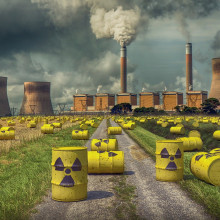
46:51 - The problem of nuclear waste
The problem of nuclear waste
Claire Corkhill, University of Sheffield
Our issues with radioactivity though are obviously not behind us. A major headache today is how to handle and safely store nuclear waste. Here in the UK, we’ve got 650,000 cubic metres of the stuff - enough to fill Wembley Stadium - and it’ll be radioactive and dangerous for 100,000 years. Claire Corkhill is at the University of Sheffield where she works on ways to store this stuff safely, and she joined Chris Smith and Adam Murphy...
Claire - It starts with the nuclear fuel from a nuclear reactor, which is uranium; and much like the bombs that we just heard about, the atoms inside it split to create energy. They release that in the form of heat, which we then use to boil water, which gives us electricity. But in a nuclear reactor we have some way of controlling the splitting, so we've got some brakes where we can slow it down and control it so it doesn't end up like a bomb; but that material, when it's been finished with in the reactor, we recycle it. So it contains a lot of uranium and plutonium which we can then turn into new fuel. And the byproducts of the recycling are nuclear waste. These byproducts are smaller atoms, so as the uranium atom for example splits, it makes smaller atoms which are also highly radioactive, we call these fission products. They end up being mixed with a type of glass which is not too dissimilar from the Pyrex that you have, Pyrex dishes that you have in your kitchen. And we turn this waste into a very durable glass. Everything else that's leftover from that recycling process is usually encapsulated inside a cement material. And then there are a whole range of other materials that we don't yet class as a waste, but they might be a waste in the future; for example, the plutonium that we've been recycling, we don't actually have a plan to turn that into new fuel yet.
Chris - So what do we do with all this stuff? We end up with these barrels of what looks like glass or concrete; that sounds fine. What do we do, just bury them?
Claire - Well, they're currently packaged in specially-engineered containers and stored in over 20 different secure nuclear sites around the country, and most of it is at Sellafield in Cumbria. And these stores are designed to withstand extreme weather and earthquakes. But the problem that we have is that the waste is so radioactive, we can't actually go anywhere near it. If you were to touch the outside of one of the glass waste containers, the radiation dose that you'd receive is 200,000 times more than a fatal dose of radiation. So whilst it's okay to store the waste securely for the time being, it's clear that we need a more permanent solution that requires less security. So remember, these wastes will be radioactive for over a hundred thousand years and they'll be highly radioactive for several thousands of years, so we can't just leave them in their warehouses and hope that future civilizations will know what to do with them.
Chris - Now will they remain intact though? Because the key question... today it looks like glass, but with that much radioactivity spitting out that much energy, will it remain like that and in a stable form for the next a hundred thousand years, if we store it ideally, or is there a danger it might not?
Claire - That's a really good question, and that's really what we've been doing a lot of work on at the University of Sheffield. These nuclear waste materials will change over the hundred thousand years that they'll be radioactive. And there are some different ways that this might occur. One would be corrosion, so the natural corrosion of the materials once they're buried deep under the ground, which is their final disposal route; if they slowly corrode in groundwater they may release their radioactivity. But the other issue is, as you rightly noted, that the radioactivity inside the waste might actually cause the waste itself to break down. And you can think of this as a highly energetic particle, a bit like was described before with breaking DNA; instead of breaking DNA we're actually breaking the intrinsic chemical bonds inside our nuclear waste material, and this will essentially cause the waste to disintegrate. And this is something that we have to understand.
Chris - So what you're saying is, if we've got say something that looks like glass, because it's spitting out all these energetic particles of radiation all the time, it's slowly going to shatter the glass. It's almost like shaking the glass very, very hard for hundreds of thousands of years; it's eventually going to fall to pieces and it will no longer be any good at retaining and constraining the radioactive products inside.
Claire - Essentially yes. I mean, glass is a very good material because it has a very flexible structure, and if you break one bond it's not going to affect the material. If you were to use something that was a bit more of a crystalline structure, this might cause you a problem. But actually what we're doing is trying to look at designing new types of wasteful materials that are based on natural uranium-containing minerals that we know are millions of years old. And while their chemical bonds have been broken by radioactivity, they haven't disintegrated and they haven't released their radioactive elements. And so these are the kinds of materials that we're now trying to develop for nuclear waste.
Chris - And are these... effectively mineral cages, that you're talking about making, are they any good? What studies have we done to say that if we bake this kind of cake and we put these materials into this molecular architecture, that it will actually perform better than what we can do with our present generation of things like glass and cement and so on.
Claire - So one really good example is a mineral called zirconalite. And these are some of the oldest minerals known on earth - there are some that are slightly older - but they contain uranium. And we know that they contain uranium because they today contain lead, which is the stable isotope that uranium decays to at the end of its decay chain. Which means that over the millions and millions of years that these minerals have existed on the earth's surface, they've managed to contain their radioactivity safely. They've gone amorphous, which means their crystal structure has broken, but they're still intact. And what's more, we know that despite the fact they've been on the surface for such a long time and there's been lots of weathering and lots of geological events, that they haven't changed and they haven't been weathered, and as I said they still contain their uranium. So we base our design on minerals likes zirconalite. And so one of the pieces of research we're doing at the moment is looking at how to dispose of the huge stockpile of plutonium that we have in the UK. And actually is zirconalite is the ideal mineral material that we can develop to immobilise plutonium safely so that it doesn't get into the wrong hands in the future.
Adam - How do we design something in the future so that this stuff stays where it is, and isn't archeologist bait, and they suddenly dig up a radioactive cube of glass?
Claire - At the present time we are thinking that we will not mark when nuclear waste is kept. It's going to be buried deep below the ground and nobody will know it's there. The worry about putting a marker on the surface is that it will automatically draw, humans particularly because we're very inquisitive, to that site to find out what's going on. And the example that I like to use is of the hieroglyphs on the pyramids, which clearly said, in a language that nobody understood at the time, don't enter or you will be cursed. But the archaeologists of the time were fascinated and thought, "well we must go inside and see what's in there." And so sometimes leaving a marker may give you the result that you didn't want, and people might then use that as a reason to go down and start looking for the waste. So the plan at the moment is to not mark the waste and hope that people forget about it; and that if in the future they decide to dig there, they have the technology to dig that deep - so we're talking between 500 metres and a kilometre below the ground - and if they have that technology, then they will also have some technology to be able to detect the radiation and know that they shouldn't go there.
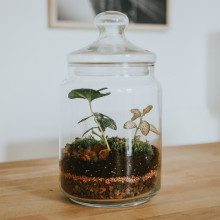
QotW: Can frogs live in terrariums?
Phil Sansom has been croaking out an answer to this question from Jon...
Phil - So Jon has got his pet frogs living in a tank with some earth, plants, and moss. It sounds like he left some holes in there, thank god, but what would happen oxygen-wise if he shut them in for good? Here’s plant scientist Stephanie Smith.
Stephanie - There’s two processes involved in this question: photosynthesis and respiration. Photosynthesis uses carbon dioxide and water, and in a reaction powered by light energy, produces glucose for plants – and it produces oxygen as a by-product.
Phil - And then the other process, respiration, is sort of the opposite. It’s the one both plants and animals use to get their energy. It takes sugar in - that’s glucose - which combines with oxygen, and it makes energy, plus some carbon dioxide and water on the side.
Stephanie - You might have noticed that the by-products of respiration are the starting ingredients for photosynthesis, so can the plants just run the two processes in perfect balance? To some degree, yes! In 1960, a reverend called David Latimer placed a spiderwort plant in a huge sealed bottle garden. It has survived unopened since then. So we know plants survive pretty well in sealed tanks. But what would happen if you introduced an animal?
Phil - Both the plants and frogs would be using oxygen for respiration, but the plant would also be producing extra oxygen from photosynthesis. Leaving aside the question of frog food, we want to know - in the words of listener Jon "who would win, the frogs or the plants?"
Stephanie - It would depend on the size of the tank and the number of plants – after all, the earth itself is a similar system on a huge scale! The practical answer is more complex. Researchers in Arizona built a facility called ‘Biosphere2’ to see if eight humans could survive in a sealed system for two years. The oxygen levels fluctuated wildly, and extra oxygen had to be injected into the system to keep the people alive.
Phil - Biosphere 2 ran two such experiments in the nineties, and they ultimately ended in a bizarre story of sabotage and takeover by the now far-right US news mogul Steve Bannon. But that’s another story, and regardless: if the oxygen fluctuates wildly in the Biosphere 2, which is a 3-acre compound, it certainly does in terrariums that are about half a metre across.
Stephanie - It drops a lot at night when there is no light to power photosynthesis. Although certain small insects can deal with these oxygen fluctuations well, most animals cannot.
Phil - So Jon, there you go: either make sure your sealed terrarium is an acre or so wides, or stick to your ones with holes in the sides. Thanks for that question. And next week’s is ‘special delivery’ from Pavel..
Pavel - On one of the Naked Scientists programmes it was mentioned that a newborn baby has initially sterile intestines and gets most of its microbiome during the passage through the uterus and vagina. What happens to children that are brought into this world via caesarean?
Related Content
- Previous Changing Minds
- Next Can frogs survive in a sealed terrarium?










Comments
Add a comment